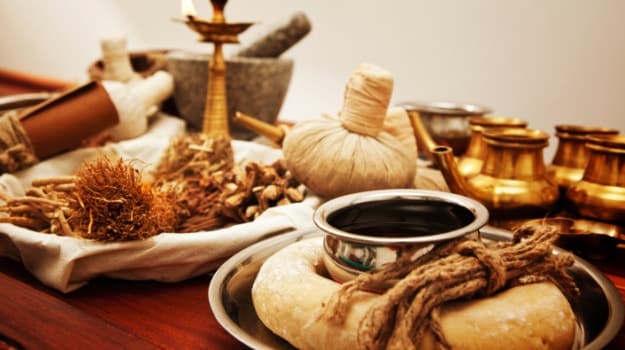|
|
|
Special Products
|

|

|
|
|
|
|
|
NEWS |
|
How to Avoid Falling Sick During Monsoons? Follow These Ayurvedic Tips
|
|
More » |
|
|
|
|
|

|
|
|
|
 |
|

|
|
|
  |
   |
|
|
|
|
News
|
|
|
| |
|
|
How to Avoid Falling Sick During Monsoons? Follow These Ayurvedic Tips
Adharika Kapoor | Updated: July 12, 2017 16:38 IST

Highlights
- The dosha that is accumulated during the rainy season is the pitta
- This leads to a loss of appetite due to the sluggish digestive system
- You must eat well-cooked food, avoid spicy food and try panchakarma
A downpour during the rainy season is often welcomed with great enthusiasm as well as a sigh of relief. After months of scorching heat, the rains help everyone bounce back with fresh doses of energy and vigour. But along with long spells of showers, the monsoonmonths also bring with them extended bouts of illnesses and several seasonal colds and allergies. Whether its diarrhea, cholera, typhoid, dengue, malaria or chikungunia, the number of people vulnerable to these diseases increases manifold during the rainy season. Ayurveda has a few handy tips that might help you guard your family and yourself against some of these.
According to the science of Ayurveda, the dosha that is accumulated during the rainy season or varsha, is the pitta. This is due to the acidic conditions in the atmosphere which increases the susceptibility of diseases and reduces the digestive processes in the body. This in turn leads to a loss of appetite due to the sluggish digestive system.
Image credit: IStock
What you must do
There are a range of dietary habits and tips that one must keep in mind to ensure consistency of the immune system and strengthening of the immune system to combat the growth of bacteria in the body. Hair loss, skin infections and indigestion occurs due to the accumulation of Pitta. According to Dr. Dhanvantri, Ayurvedic expert, the monsoon requires everyone to ensure certain precautions are taken in order to remain in the best of health. He suggests the following tips to follow during this season.
1. Eat well-cooked food: Avoid food that is uncooked and raw. Only food that is well cooked and hygienic must be consumed. Food from street vendors must be avoided. During the rainy season, the bacteria sticks to the food making it unfit for consumption.
2. Avoid spicy food: Greasy and spicy food with too many chillies might not be suitable for everyone. It might hinder effective digestion. Oil free food is a must. Wheat and barley along with moong dal soup and freshly boiled water help boost immunity. They also enable the toxins of the body to get flushed out, maintaining ones health and reducing vulnerability. All of these are loaded with minerals and vitamins and replenish the body with the nutrients it desires for proper functioning.
3. Try panchakarma (under expert supervision): In Ayurveda, Panchkarma as the name suggests, is a fivefold healing procedure that involves removing the toxins of the body that have been leftover by diseases. It is a complete mind-body healing process that restores the balance of the body. It involves the use of herbal methods, massages, oil based remedies that allow the body’s own organs to rejuvenate themselves. It is a season based therapy and is advocated especially during the monsoon.
(Also Read: The Ayurvedic Principle of Foods That Heat Up and Cool Your Body )
Image Credit: IStock
What Ayurveda suggests you should not do during the monsoon season
1. Do not consume green leafy vegetables or cooked vegetables that are now stale.
2. Do not have milk during the day and curd during the night. What you eat is as crucial as when you eat it. Ayurveda suggests that you don’t have fruits along with milk. Milkshakes and such fruit based drinks may slow down the digestion even further, according to the science of Ayurveda.
3. When thirsty, quench your thirst with normal temperature water and not extremely cold water.
( Also Read: 5 Remarkable Home Remedies for Seasonal Allergies )
4. Do not sleep during the day, it makes one lethargic.
5. Do not spend too many hours in the sun and avoid the air conditioner immediately after a work-out as you tend to sweat and it can lead to temperature difference between the body and the external environment.
6. As alternatives, oils that are light in nature such as olive oil can be used for cooking.
7. Avoid sour items such as chutneys and pickles and increase the consumption of fresh fruits and vegetables. Incorporate lots of Tulsi or green tea in your diet regimen. These herbal teas have healing properties.
Image Credit: IStock
Above everything, know your stomach. It varies from person to person and it is important to be aware of what might suit you. Be informed about what works for your body to keep yourself strong and healthy in this uncertain rainy season. Lastly, make sure you stay away from disease-spreading mosquito. For a natural way out – try fumes of fried neem leaves as a mosquito repellent to keep illnesses at bay.
|
|
|
|
Try Ayurveda for hair loss
For thousands of years, men and
women of all countries and races have shared the tragedy of pre-mature hair
loss.
According to Ayurveda, the hair is derived either as a
by-product or produced as a breakdown product of Asthi (bone tissue). Any
disturbance in this tissue metabolism, which very much depends on the digestive
fire, can affect the health of the hair. To a certain extent, the quality of
hair depends on the body constitution.
The reason for hair loss is a subject that no two doctors, seem
to agree on and everyone seems to have their own opinion on the subject. The
major causes of hairfall are hormonal, nutritional deficiencies and
complication to other diseases and medications. Hormone related hair fall may
also result from an increased sensitivity of hair follicles to male hormones or
due to greater number of male hormone receptors attached to hair follicles.
This is the component that is inherited through the genes - termed as Pitta
constitution.
According to Ayurveda, excess of Pitta dosha in the body is increased by hot
climatic conditions, excessive intake of spicy, salty and sour food, hot and
sharp food, tea, coffee, alcohol, meats and excessive smoking. Eating too much
fried, oily, greasy, and acidic foods also aggravates Pitta. Pitta balancing
herbs (Eg: Shatavari -Asparagus) and vegetables which improves the quality of
Asthi dhathu (Eg: bitter vegetables) are effective in treating hair fall.
There are a number of other causes for hair fall like acute illness, high
stress, and thyroid imbalance, certain drugs, sudden weight
loss and high fever.
The first step is to locate the root cause in your diet or lifestyle that may
be increasing the Pitta dosha. Once you locate it, try to give up or at least
reduce the diet, habit, or activity responsible for increasing Pitta. Internal
use of Ayurvedic medicines like Thikthakam kashayam, Thikthakam ghritham as per
medical advice are effective to correct the metabolism. Ayurvedic general
tonics like Narasimha rasayanam, Chyavana prasam are effective for improving
hair growth. In alopecia, due to systemic diseases, treatment of the same is
also required.
General recommendations and tips to maintain the results are some of the
following:
- A high protein and an iron rich diet is recommended for hair loss. An
adequate intake of raw vegetables, fresh fruits, salads, green leafy vegetables
should be included in the diet on a regular basis. - Use a natural shampoo to clean the hair. Amla (embilica officinalis),
Shikakai (Acacia concinna) are very good for washing the hair. - Oiling and
massaging of scalp is very beneficial for stopping the hair loss. Use coconut
oil at least three times in a week. Certain medicated oils like Neelibhringadi
oil, Kunthala kanthi oil, Kanjunnyadi oil are very useful. Put oil on the scalp,
and massage gently in the roots of the hair.
- The person should maintain a regular bowel movement everyday. In case of
constipation, a mild natural laxative can be taken. Triphala is very useful. -
Regular physical exercise is very beneficial as it helps in balancing the
aggravated doshas. - Rub your scalp after washing the hair. It increases the
blood circulation, and activates the sebaceous glands. - A mixture of lettuce
and spinach juice is good to drink to induce hair growth. The juice of carrot, and
lettuce juice is also good to take. - Applying juice of green coriander leaves
on the head is also good. - Washing the hair with a paste of cooked green gram
and fenugreek (methi) two to three times a week, is also good. - A paste of
licorice made by grinding it in milk can be applied in the bald patches. - The
seeds of fenugreek is soaked in coconut oil and kept under direct sunrays for
seven days and applied to the scalp, which prevents hair loss. - Traditional
therapies like Dhara, Abhyangam, Thala pothichil, Nasya shows excellent
effects.
(Inputs by Dr V L Shyam MD, MPhil)
The Times of India 12 Dec 2011
|
|
|
|
Happy Onam from Kerala.
Good News….. Ayurveda treatments under mediclaim umbrella
Till some time back, health insurance policies used to cover only allopathy treatment while ayurveda, homeopathy, naturopathy and unani treatments were left out of the ambit. Despite having a comprehensive health insurance plan in place, individuals who preferred such systems had to pay out of their own pockets.
These policyholders can now breathe easy as some insurance companies have started including such alternative forms of treatment under their cover, especially ayurveda. "Ayurveda being the most prevalent of the alternate systems, we have designed a product to cover treatments under ayurvedic hospitalization," says S S Gopalarathnam, managing director, Cholamandalam MS General Insurance.
While some insurers only offer it under their group policies, others have started offering the facility to individual health insurance seekers. PSU insurer New India Assurance and standalone health insurance provider Star Health and Allied Insurance are other insurance companies that have started covering ayurvedic treatments under individual policies. ICICI Lombard General Insurance covers it under government scheme and Future Generali Insurance offers it to corporate group insurance buyers from which employees of the covered company can benefit. Naturopathy treatments are excluded in all policies, while few cover unani and homeopathic. This is because other forms of treatments have no standard treatment protocols and highly varied costs thus making it difficult to actuarially compute the cost to be covered.
Even under ayurveda, select procedures are covered to ensure people do not misuse a policy for a basic rejuvenation procedure. It is important to note that there is no standalone cover available for covering alternative treatments. You will have to buy a standard health insurance cover from these select insurers and others who start offering the non-allopathic coverage.
Before you head for alternative treatment and make a claim, see whether the treatment is listed in the insurance policy document. Insurers are particular about the specific treatments covered. "Snehan and Swedan are payable only when these procedures are done as a part of pre-panchkarma preparation. Comfort treatments involving steam bath/sauna/oil massages are excluded.
Source: TOI- JULY 25-2011
|
|
|
|
Not many would take interest in watching a movie that did not arise in Hollywood or Bollywood. But if Ramayana and Mahabharata could be made into movies, something that has existed for centuries now and is still made use of can definitely made into a movie as well. This thought was put into action when Pan Nalin made a movie on Ayurveda featuring five elements in visible and invisible form which is 102 minutes long filmed entirely on locations in India, Greece & USA in the year 2001. But how many of us know about this film?
The film travels nearly 15,000 kilometres through landscapes of exceptional beauty and geographical variety in India, Greece and USA. For several months Pan Nalin and his research team constantly searched out people and places almost all over the world; to do total justice to this exceptional subject, to voice the story of Ayurveda through exceptional Vaidyas (Ayurvedic Doctors), patients and experts.
Some of the Vaidyas have revealed their secrets and open their home and clinics to contribute to the film. Plant searching tribes took them into dark corner of jungle where a rare endangered plant still grows wild. Ancient Palm-leaf manuscripts locked away for 3 to 5 centuries were looked for and made use of. Ancient ‘Mud-Scanning’ method of Diagnosis has been considered extinct and lost but their months long efforts managed to track down the last surviving place. A rarely seen lost science of Marma, vital points, and how it can kill or cure; was demonstrated on a goat for the first time revealing vital points which can paralyze.
During the 3 long years while preparing the film Pan Nalin was himself surprised despite being exposed to the science of Ayurveda in his family, to discover how scientific Ayurveda is. “I personally believe that our world of today, into a new millennium, is going to need natural arts of healing like it never did ever before. Spirituality and natural balances will play a vital role in governing our happiness in near future. No single film can do justice to the vast science of Ayurveda but for me the film is just a sharing, but the sharing that inspires, naturally” quotes Pan Nalin.
Visit http://www.ayurvedafilm.com/ to read more about the film and to get a sneak peek into what’s in store in the movie.
|
|
|
|
KUALA LUMPUR: With Indian Ayurveda emerging as a popular alternative treatment in Malaysia, experts here are seeking India's support in expanding the reach of the traditional medicine among Malaysians.
The Traditional Chinese Medicine (TCM) and the Indian Ayurveda and Siddha medicine are respectively the most common alternative remedy to conventional medicine for the Chinese and Indian communities.
The president of the Malaysian Society for Complementary Medicine (MSCM) Dr Lee Chee Pheng remarked that no one wants to fall sick and the side effects of conventional drugs were pushing the society towards herbal medicine that is relatively harmless.
"Based on the market demand, TCM is the fastest growing industry in the world," Dr Lee was quoted as saying to Bernama.
In developing alternative medicine here, Dr Lee noted that India is willing to cooperate with Malaysia to explore the potential of our natural herbs.
In this respect Dr Lee invited the National Institute of Unani Medicine (NIUM) in Bangalore, India, to undertake joint research on natural herbs with the Forest Research Institute of Malaysia.
Concurring with Dr Lee, Dr VM Palaniappan a leading practitioner of alternative medicine and author of numerous books on the subject noted that the ancient Ayurveda and Siddha medicine too have been gaining popularity in Malaysia with many Ayurvedic centres cropping up over the last decade.
"I have a strong feeling that Ayurvedic system is fast picking up in Malaysia, and I will not be surprised if more people begin to seek remedies through this method.
"One of the reasons why people opt for alternative medicine appears to be the presence of undesirable side effects of chemical-based drugs used in modern medicine," said this former academician with Universiti Malaya.
Another reason for people seeking treatment using alternative method is the cost factor.
Source: Economic Times 4th Jan 2011
|
|
|
|
Kolkata, April 25, 2010 Medicinal plants help to keep fit
People from the Northeast States are endowed with good health as their diet comprises of various medicinal plants which keep their body fit.
“People of the Northeast consume a nutritional diet of many medicinal plants like Bacopa Monneri Penn, Centella Asiatica Urban, Discorea Bulbifera, Embelica Officinale Gaerth, Erygium Foeitdum and many other species found in the region that keep them fit,” speakers at a symposium on ‘Global Resurgence of Ayurveda and Yoga’ said here on Saturday.
The medicinal plants found abundantly in the Northeast were also used for healing, symposium Chairman R.K. Sharma said.
“This shows that people of the region use herbal drugs in their day-to-day life which help to keep their bodies healthy,” Sharma said.
Of the 15,000 to 20,000 varieties of medicinal plants in the country, 7,000 to 7,500 were used by traditional medicine systems in India.
“Medicinal plants are the oldest known healthcare products and their importance is still growing although it varies depending on the ethnological, medicinal and historical background of each country,” Sharma said.
He said that ayurvedic products as an alternative system of medicine, and many herbal products of Indian origin, had good potential to win a considerable share of the world market.
Ayurveda has been recognised as a healthcare system by the UK, the UAE, Sweden, Indonesia and the US. Thirty more countries would be accepting it as an alternative system of medicine.
In the light of such a situation, he said, there was a need for establishing backward and forward linkages for the herbal sector and strategies for their seamless integration for a sustainable growth-oriented performance, specifically on the export front.
Source: The Hindu Newspaper
|
|
|
|
|
|
|
|
|
|
|
|